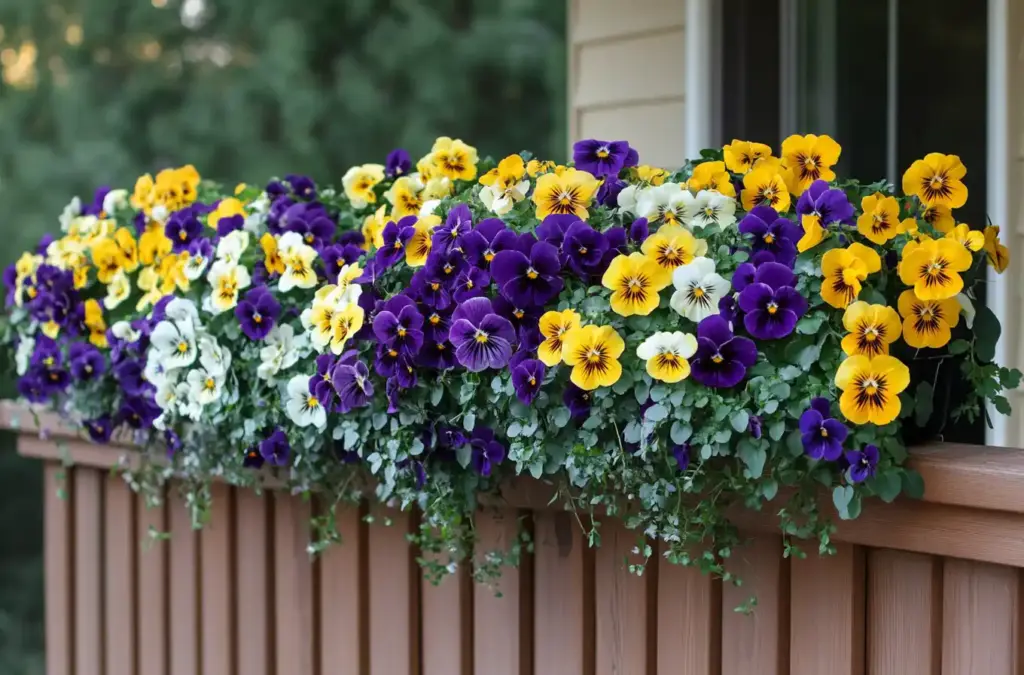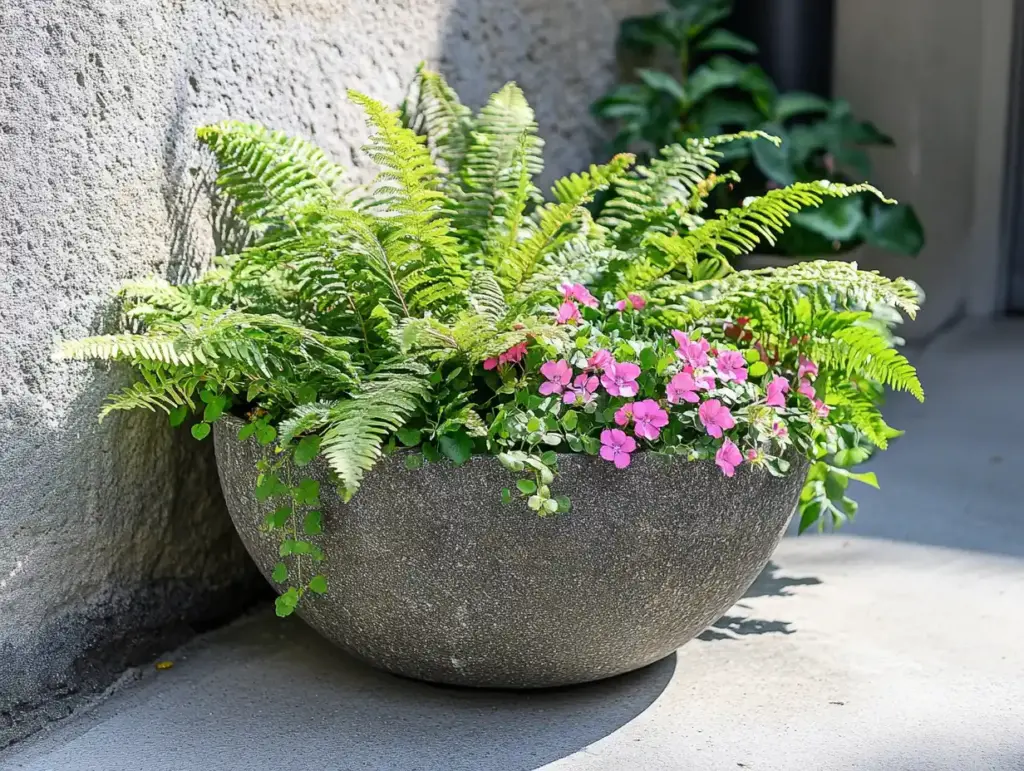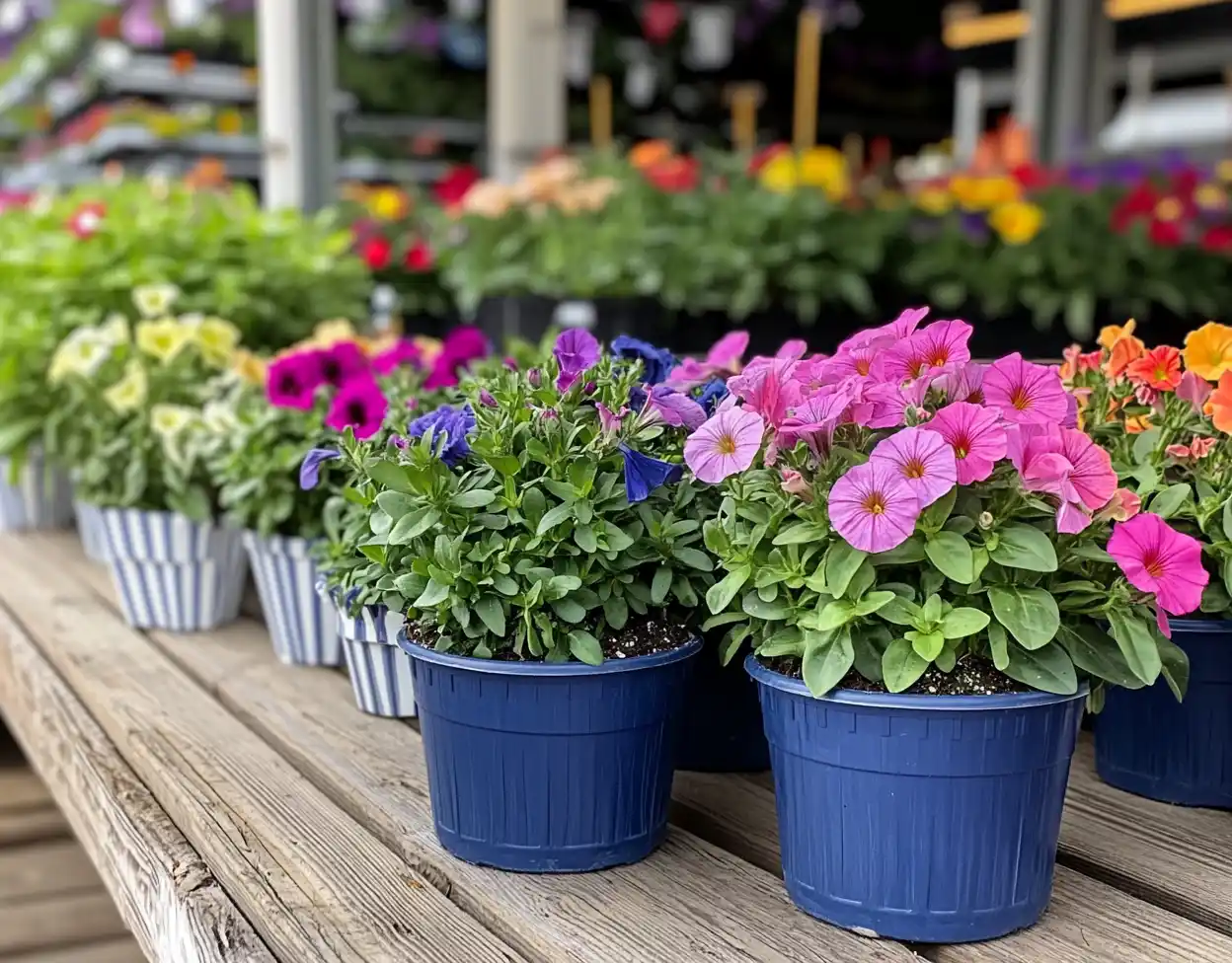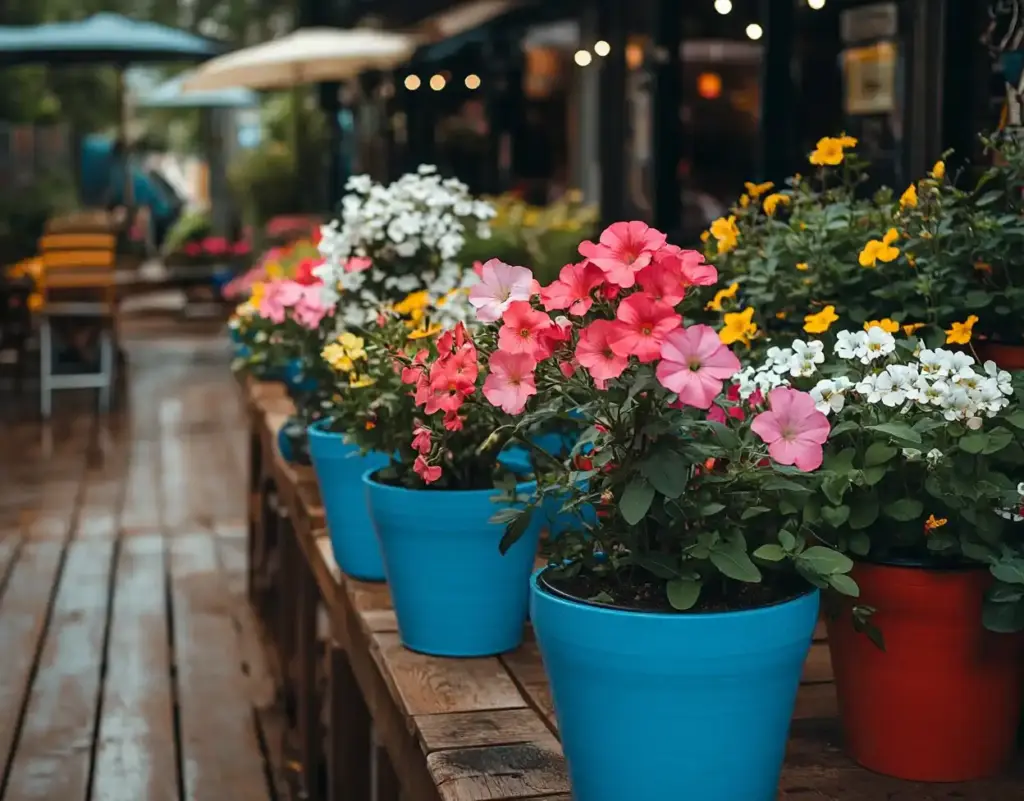When winter approaches, your vibrant front porch flower pots don’t have to become a seasonal memory. With a thoughtful plan and a few smart tips, many of the colorful plants you’ve nurtured all summer—especially those featured in our guide to the best porch potted plants—can be overwintered indoors or left outside if they’re cold-hardy enough. Learning which plants to bring in and how to protect those left outdoors helps preserve your investment and keeps your front porch flower pots looking polished year-round.
Whether you’re showcasing tropical blooms, hardy evergreens, or seasonal stunners like outdoor hostas in pots, this guide shares everything you need to know—from plant selection and container prep to winter storage and pest control. With a special focus on extending the life and color of your front porch flower pots, you’ll be ready to maintain porch curb appeal, even in the coldest months.
🌿 Love gardening inspiration? Follow me on Pinterest for bold plant ideas, tips, and seasonal color!
Table of Contents
🌿 Plants to Bring Indoors for Winter
If your front porch flower pots are home to tropical or tender perennials, bringing them indoors before winter sets in can mean the difference between thriving houseplants and seasonal loss. These plants aren’t equipped to survive freezing temperatures, but with the right indoor care, they can return to your porch next spring as strong as ever.
Tropical and Tender Plants to Overwinter Indoors
Many of the most colorful and lush plants used in front porch flower pots are native to warm climates. These should always be brought inside before the first frost:
- Calla Lilies
- Canna Lilies
- Ginger
- Gladiolus
- Palms (including Majesty and Areca)
- Citrus Trees (lemon, lime, etc.)
These tropicals need warm temperatures and plenty of light. Place them near sunny windows or under grow lights indoors.
Flowering Favorites and Foliage Plants
These bloomers and foliage plants are also popular in container gardens and make excellent indoor companions through winter:
- Hibiscus
- Geraniums (Pelargonium)
- Begonias
- Mandevilla
- Oleander
- Caladium
- Angel’s Trumpet
These plants can continue to add beauty indoors but may drop some leaves while adjusting to indoor conditions.
Colorful and Hardy Accent Plants
Some plants in front porch flower pots serve as accent pieces or fillers—and they’re worth saving:
- Succulents – Ideal for sunny indoor spots
- Coleus – Grown for its vibrant foliage
- Herbs – Especially basil, parsley, rosemary, and mint
Herbs not only survive indoors but also provide fresh flavor for winter meals.
💡 Pro Tip: If you’re short on space indoors, prioritize bringing in your most valued or expensive plants. Otherwise, choose plants that match your region’s average low winter temperatures to stay outside.
🌲 Cold-Hardy Plants That Can Stay Outside
Not all plants in your front porch flower pots need to head indoors for the winter. Some resilient varieties can handle freezing temperatures with ease—especially when properly cared for and planted in the right containers.
These outdoor champions bring color, structure, and greenery to your home’s entrance year-round, even when the rest of your garden goes dormant.
Evergreen All-Stars for Winter Resilience
- Japanese Yew & Brown’s Yew
These evergreen shrubs are cold-hardy, drought-tolerant, and low-maintenance. Their rich green needles add elegant structure to front porch flower pots, especially in winter when most foliage disappears. - Potted Blue Spruce
Known for its silvery-blue needles, the blue spruce doubles as a living Christmas tree. It thrives in full sun and prefers evenly moist but well-drained soil. - Cypress Topiaries
These sculpted evergreens love morning sun and afternoon shade. They make standout centerpieces in winter containers but are sensitive to overwatering—so drainage is key. - Boxwoods
Popular in symmetrical container designs, boxwoods require weekly watering and plenty of sunlight. Their dense, compact form offers excellent winter appeal.
Cold-Season Bloomers for Color
- Violas
Surprisingly tough, violas often flower through snow. With good drainage and occasional deadheading, they’ll brighten up front porch flower pots even in January. - English Primrose
Available in vibrant reds, purples, and yellows, primrose starts blooming in cooler temperatures. These plants need regular watering and can tolerate full winter sun.
🌟 Helpful Hint: To protect these cold-hardy plants even further, choose durable winter containers (we’ll cover that next) and avoid letting pots sit in standing water.
🪴 Best Winter Containers for Front Porch Flower Pots
Choosing the right container is just as important as selecting the right plants—especially when temperatures dip below freezing. The wrong pot can crack, crumble, or fail to protect delicate roots. To ensure your front porch flower pots survive the winter in style, opt for materials built to handle the cold.
Containers That Withstand Winter Weather
These pot types offer excellent insulation and durability for cold months:
- Fiberglass – Lightweight yet strong, it’s less likely to crack from frost.
- Iron – Durable and elegant, though it can be heavy.
- Stone – Offers excellent insulation and a classic look.
- Concrete – Extremely hardy and great for permanent fixtures on your porch.
- Heavy Plastic – A cost-effective option that resists temperature swings.
These materials maintain structural integrity during freeze-thaw cycles, helping protect plant roots from sudden drops in temperature.
Containers to Avoid in Winter
Some materials may look beautiful in warmer months but can fail when winter sets in:
- Terra Cotta
This porous clay absorbs water, which expands when frozen—leading to cracking or complete breakage. - Unglazed Ceramic
Like terra cotta, it absorbs water and is prone to cracking unless kept dry and protected. - Hanging Baskets
These offer little insulation and dry out quickly in cold, windy conditions—leaving root systems vulnerable.
✅ Winter Tip: If you’re attached to using decorative pots that aren’t winter-hardy, consider double-potting. Place a plastic container inside the decorative one to insulate and protect your plant without sacrificing aesthetics.
🛡 Winter Protection Tips for Front Porch Flower Pots

Even the hardiest plants and sturdiest pots need a little extra TLC to make it through winter unscathed. If you’re keeping your front porch flower pots outside during the colder months, follow these smart winterizing strategies to protect both roots and containers from frost damage.
1. Don’t Overwater
In cold weather, most plants slow down or go dormant, so they need far less water. Overwatering in winter can lead to:
- Root rot
- Frozen soil (which expands and damages roots)
- Mold or mildew buildup
Use well-drained potting soil and water only when the top inch of soil feels dry to the touch.
2. Remove Pot Saucers
Leaving pots sitting in water-filled saucers can cause:
- Freezing of pooled water
- Cracked containers
- Rotting root systems
Always empty saucers or remove them entirely during the winter season.
3. Insulate the Roots
Keeping your plant’s root system warm is the key to winter survival. Here are three effective methods:
- Use Larger Pots: Bigger containers hold more soil, which provides better insulation against temperature swings.
- Wrap the Pots: Wrap your front porch flower pots with burlap, bubble wrap, or even an old blanket to buffer roots from the cold.
- Bury the Pots: If possible, sink your potted plants—container and all—into the ground and cover with mulch. This shields roots from deep freezes.
🛠 Quick DIY Tip: For extra insulation, stuff straw, leaves, or packing peanuts between the pot and its outer wrap. It’s cheap, effective, and plant-safe.
⏰ When to Bring Plants Indoors

Timing is everything when it comes to transitioning your front porch flower pots indoors for the winter. A sudden frost can cause irreversible damage to tender plants, so being proactive—not reactive—is key to keeping your container garden thriving year-round.
Watch the Weather — Closely
The best time to bring plants inside is before the first frost. Depending on your region, this could be anywhere from early October to mid-November. Monitor your local weather forecast and be alert for frost or freeze warnings.
- Light frost: 32°F or lower — may damage sensitive plants
- Hard freeze: Below 28°F — can kill many tropicals instantly
Know Your USDA Hardiness Zone
Use the USDA Plant Hardiness Zone Map to determine what kind of winter temperatures your area typically experiences. This helps you decide which front porch flower pots must come inside and which can safely stay outdoors.
For example:
- Zones 9–11 may allow some tropicals to stay outside year-round.
- Zones 6–8 usually require indoor storage for most non-hardy plants.
- Zones 5 and below demand extra precautions and early preparation.
Don’t Wait Until the Last Minute
Plants need time to adjust. A rushed, last-second move can cause:
- Leaf drop
- Shock
- Stunted growth
🌡 Pro Tip: Start moving plants to a transitional space like a garage or covered porch a week before they fully come indoors. This helps them acclimate gradually to lower light and humidity.
🏠 How to Store Plants Indoors
Once your front porch flower pots are safely inside, your job isn’t over. Proper indoor storage is essential to help plants adjust and thrive through the winter months. From light conditions to temperature control, creating the right indoor environment can make all the difference.
Step 1: Let Plants Acclimate Gradually
Bringing plants directly from cold outdoor air into a heated home can shock them. Use a transition space like a garage, covered porch, or sunroom where the temperature changes more gradually.
This helps:
- Reduce leaf drop
- Lower the risk of transplant shock
- Mimic natural seasonal changes
Keep them in this space for 3–5 days before moving them fully indoors.
Step 2: Provide the Right Temperature Range
Most tropicals and tender perennials from front porch flower pots prefer temperatures between 55°F and 70°F indoors. Avoid placing them near cold drafts, heating vents, or radiators, which can stress plants.
❄️ Winter Warning: Heated air may dry out plant leaves quickly. Consider misting or using a humidifier if your home is very dry.
Step 3: Light It Up
Indoor light often falls short of what your outdoor plants are used to. Choose bright, sunny windows that face south or west, or invest in grow lights to maintain healthy foliage and blooming.
- Rotate pots weekly to ensure even growth
- Clean dust off leaves to maximize photosynthesis
- Use timers on grow lights to simulate natural daylight
Step 4: Keep Pets and Kids Safe
Some plants that looked beautiful in your front porch flower pots—like angel’s trumpet or oleander—are toxic if ingested. Keep them on high shelves, in hanging baskets, or behind barriers.
🐾 Safety Reminder: Even non-toxic plants can cause upset stomachs in pets. It’s best to err on the side of caution.
🌱 Indoor Plant Care Tips
Now that your front porch flower pots are snug inside for the winter, the focus shifts to keeping them healthy in their new indoor environment. While winter plant care is generally lower-maintenance, it does require attention to detail. Overwatering, poor lighting, and environmental stress can all impact your plant’s ability to survive until spring.
1. Don’t Overwater
Indoor plants grow more slowly in winter—or may go dormant altogether. That means their water needs are minimal.
Water only when the top inch of soil feels dry. Signs of overwatering include yellowing leaves, moldy soil, or mushy stems. Always check drainage holes to ensure excess water can escape.
2. Expect Some Leaf Drop
It’s normal for plants to lose a few leaves after moving indoors. This doesn’t mean they’re dying—it usually means they’re:
- Adjusting to lower light and humidity
- Entering a dormant or semi-dormant phase
- Reallocating energy to root growth
🪴 Pro Tip: If new growth appears leggy or pale, supplement with a grow light to mimic stronger sunlight.
3. Hold Off on Fertilizer
Your front porch flower pots don’t need fertilizing while the plants are resting. Wait until early spring, when you see signs of active new growth.
4. Prune Sparingly
Lightly trim any leggy or dead stems, but avoid heavy pruning during dormancy. Pruning too aggressively can stress a resting plant and reduce its ability to rebound in spring.
🐛 Prevent Pests Indoors
One of the most overlooked parts of bringing your front porch flower pots indoors is pest control. Unwanted hitchhikers—like aphids, fungus gnats, or spider mites—can quickly spread to other houseplants if not handled properly. The good news? A few preventative steps can keep your indoor garden clean and healthy all winter long.
Common Leaf-Dwelling Pests
These critters often hide on stems and the undersides of leaves:
- Aphids
- Spider mites
- Mealybugs
- Whiteflies
- Scale
- Lacewings
What to do:
Before bringing any plant inside, gently spray the foliage with water using a hose or showerhead. This dislodges eggs and bugs you may not see. After rinsing, inspect under leaves and along stems for clusters or webbing.
If pests persist, use an insecticidal soap or neem oil and isolate the plant from others until it’s pest-free.
Common Soil-Dwelling Pests
Don’t forget what’s hiding below the surface. Pests that live in the soil of your front porch flower pots include:
- Fungus gnats
- Slugs
- Sowbugs
- Ants
- Earwigs
How to treat soil pests:
- Remove visible bugs manually
- Apply a soil-safe pesticide to the top layer
- Clean around drainage holes, where many pests gather
🧼 Pro Tip: Avoid bringing in any pots that had visible infestations outdoors. Sometimes it’s better to compost the soil and restart with clean potting mix.
🌼 Moving Plants Back Outdoors in Spring
After a long winter indoors, your front porch flower pots are probably eager to return to the sunlight—and so are you. But resist the temptation to move plants outside too early. A little patience and a gradual transition process will help avoid shock and set your plants up for a vibrant growing season.
Step 1: Watch Nighttime Temperatures
Your plants are safe to move outside when night temperatures consistently stay above 45°F (7°C). Sudden dips below freezing can undo months of careful overwintering.
Check your local frost calendar or use a garden app to monitor conditions before making the move.
Step 2: Reacclimate to Outdoor Conditions
Indoor plants have adapted to lower light and steady temperatures. To prevent sunburn and stress:
- Start in a shaded area, like under a covered porch
- Gradually increase sunlight exposure over 7–10 days
- Avoid windy or exposed spots during the first few days
🌤 Pro Tip: Overcast days are ideal for starting the transition—it helps plants adjust to outdoor light without sudden intensity.
Step 3: Resume Outdoor Watering Routines
Once your front porch flower pots are back in their usual spot, adjust your watering based on weather:
- Water more frequently as temperatures rise
- Ensure pots have proper drainage to prevent soggy roots
- Refresh potting soil if compacted or depleted
Don’t be surprised if plants experience a little leaf yellowing or drooping at first—this is normal as they adjust.
🌿 Conclusion
Keeping your front porch flower pots healthy and thriving through the winter doesn’t have to be a mystery. With the right mix of preparation, seasonal care, and smart plant choices—like those in our summer-to-winter potted plant guide—you can enjoy lush greenery and colorful blooms year-round, both indoors and outside.
From selecting cold-hardy varieties to choosing the best winter-friendly containers, these strategies will help your front porch flower pots shine through every season. Preventing pests, using smart insulation techniques, and learning when to transition plants in and out of your home can make all the difference when protecting your outdoor investment.
Whether you’re a seasoned green thumb or just starting out with front porch decor, these winter plant care tips will keep your front porch flower pots flourishing and your entrance looking fresh, inviting, and full of life—no matter the weather.
❓ FAQ: Winter Care for Front Porch Flower Pots
Q1: Can I leave my front porch flower pots outside all winter?
Yes, but only if they contain cold-hardy plants and are in weather-resistant containers like fiberglass or stone. Avoid terra cotta and unglazed ceramic, which can crack in freezing temperatures.
Q2: What is the best way to protect outdoor potted plants in winter?
Use larger containers for better root insulation, wrap pots with burlap or bubble wrap, and avoid overwatering. If needed, bury the pots in the ground and mulch around them for extra warmth.
Q3: When should I bring my potted plants indoors for winter?
Bring them in before the first frost—typically when nighttime temps fall below 45°F. Watch your local forecast and avoid last-minute moves that could stress the plant.
Q4: Do I need to change the soil when I move pots back outside in spring?
Not always, but it’s a good idea to refresh the top layer or repot if the soil is compacted, has poor drainage, or had pest issues during winter.
Q5: What indoor conditions are best for overwintering front porch flower pots?
Keep plants in temperatures between 55°F–70°F, provide bright light or grow lights, and avoid drafts or heat vents. Water sparingly and check for pests regularly.


